Photovoltaic Solar Electrochemical Oxidation (PSEO) For Treatment Of Lignosulfonate Wastewater
Photovoltaic Solar Electrochemical Oxidation (PSEO) For Treatment Of Lignosulfonate Wastewater
Source: https://www.soci.org
Author: Antonio Dominguez-Ramos, Ruben Aldaco and Angel Irabien
Usually dispatched in 2 to 3 days
Usually dispatched in 2 to 3 days
Category:
Researches
Only logged in customers who have purchased this product may leave a review.
Related products
Correlation Between BOD5 and COD for Al- Diwaniyah Wastewater Treatment Plants to Obtain The Biodigrability Indices
ABSTRACT
The present study aims to establish an empirical correlation between biochemical oxygen demand (BOD5) and chemical oxygen demand (COD) of the sewage flowing in Al-Diwaniyah wastewater treatment plant. The strength of the wastewater entering the plant varied from medium to high. High concentrations of BOD5 and COD in the effluent were obtained due to the poor performance of the plant. This was observed from the BOD5 /COD ratios that did not confirm with the typical ratios for the treated sewage. Regression equations for BOD5 and COD removal percentages were suggested which can be used to evaluate rapid effluent assessment after the treatment processes or optimal process control to improve the performance of wastewater treatment plants. The average Biodegradability indices (B.I) of Al-Diwaniyah wastewater plants was found to be 0.69. The equations relating the percentage removal of BOD5(y) with influent BOD5(x), y= 0.044x + 80.66 and the percentage removal of COD (y) with influent COD (x), y= 0.045x + 55.15 were found with high correlation R2 =0.72 and 0.86 respectively. Keywords: BOD5, COD, BOD5/COD ratio, Biodegradability indices, BOD5 and COD correlations
Correlation Between BOD5 and COD for Al- Diwaniyah Wastewater Treatment Plants to Obtain The Biodigrability Indices
ABSTRACT
The present study aims to establish an empirical correlation between biochemical oxygen demand (BOD5) and chemical oxygen demand (COD) of the sewage flowing in Al-Diwaniyah wastewater treatment plant. The strength of the wastewater entering the plant varied from medium to high. High concentrations of BOD5 and COD in the effluent were obtained due to the poor performance of the plant. This was observed from the BOD5 /COD ratios that did not confirm with the typical ratios for the treated sewage. Regression equations for BOD5 and COD removal percentages were suggested which can be used to evaluate rapid effluent assessment after the treatment processes or optimal process control to improve the performance of wastewater treatment plants. The average Biodegradability indices (B.I) of Al-Diwaniyah wastewater plants was found to be 0.69. The equations relating the percentage removal of BOD5(y) with influent BOD5(x), y= 0.044x + 80.66 and the percentage removal of COD (y) with influent COD (x), y= 0.045x + 55.15 were found with high correlation R2 =0.72 and 0.86 respectively. Keywords: BOD5, COD, BOD5/COD ratio, Biodegradability indices, BOD5 and COD correlations
A Review of the Water Desalination Technologies
Abstract: Desalination is commonly adopted nowadays to overcome the freshwater scarcity in
some areas of the world if brackish water or salt water is available. Different kinds of technologies
have been proposed in the last century. In this paper, the state of the mainstream solutions is
reported, showing the current commercial technologies like reverse osmosis (RO), Multi-Stages Flash
desalination (MSF) and Multi-Effect Distillation (MED), and the new frontiers of the research with
the aim of exploiting renewable sources such as wind, solar and biomass energy. In these cases,
seawater treatment plants are the same as traditional ones, with the only difference being that they
use a renewable energy source. Thus, classifications are firstly introduced, considering the working
principles, the main energy input required for the treatment, and the potential for coupling with
renewable energy sources. Each technology is described in detail, showing how the process works
and reporting some data on the state of development. Finally, a statistical analysis is given concerning
the spread of the various technologies across the world and which of them are most exploited. In this
section, an important energy and exergy analysis is also addressed to quantify energy losses.
A Review of the Water Desalination Technologies
Abstract: Desalination is commonly adopted nowadays to overcome the freshwater scarcity in
some areas of the world if brackish water or salt water is available. Different kinds of technologies
have been proposed in the last century. In this paper, the state of the mainstream solutions is
reported, showing the current commercial technologies like reverse osmosis (RO), Multi-Stages Flash
desalination (MSF) and Multi-Effect Distillation (MED), and the new frontiers of the research with
the aim of exploiting renewable sources such as wind, solar and biomass energy. In these cases,
seawater treatment plants are the same as traditional ones, with the only difference being that they
use a renewable energy source. Thus, classifications are firstly introduced, considering the working
principles, the main energy input required for the treatment, and the potential for coupling with
renewable energy sources. Each technology is described in detail, showing how the process works
and reporting some data on the state of development. Finally, a statistical analysis is given concerning
the spread of the various technologies across the world and which of them are most exploited. In this
section, an important energy and exergy analysis is also addressed to quantify energy losses.
Removal of Escherichia Coli from Domestic Wastewater Using Electrocoagulation
ABSTRACT
The objective of this study was to evaluate the efficiency of electrocoagulation in the removal of Escherichia coli from domestic and urban wastewaters and to determine the effects of the main operational parameters on the process. An electrocoagulation reactor with aluminum and iron electrodes was built for this purpose. A factorial design was applied, where amperage, treatment time, and pH were considered as the factors and E. coli percent removal was the response variable. After 20 min of treatment, >97% removal efficiency was achieved. The highest E. coli removal efficiency achieved was 99.9% at a neutral pH of 7, amperage of 3 A, and treatment time of 60 min. However, the removal efficiency of close to 99% was also achieved at natural wastewater pH of 8.5. The statistical analyses showed that the three tested factors significantly affected the E. coli removal percentage (p < 0.05). These results indicate that electrocoagulation has a high disinfection power in a primary reactor in removing water con[1]taminants as well as simultaneously removing pathogenic microorganisms when compared to biological treatment processes. This represents an additional benefit, because it will considerably reduce the use of chlorine during the final disinfection stage.
Removal of Escherichia Coli from Domestic Wastewater Using Electrocoagulation
ABSTRACT
The objective of this study was to evaluate the efficiency of electrocoagulation in the removal of Escherichia coli from domestic and urban wastewaters and to determine the effects of the main operational parameters on the process. An electrocoagulation reactor with aluminum and iron electrodes was built for this purpose. A factorial design was applied, where amperage, treatment time, and pH were considered as the factors and E. coli percent removal was the response variable. After 20 min of treatment, >97% removal efficiency was achieved. The highest E. coli removal efficiency achieved was 99.9% at a neutral pH of 7, amperage of 3 A, and treatment time of 60 min. However, the removal efficiency of close to 99% was also achieved at natural wastewater pH of 8.5. The statistical analyses showed that the three tested factors significantly affected the E. coli removal percentage (p < 0.05). These results indicate that electrocoagulation has a high disinfection power in a primary reactor in removing water con[1]taminants as well as simultaneously removing pathogenic microorganisms when compared to biological treatment processes. This represents an additional benefit, because it will considerably reduce the use of chlorine during the final disinfection stage.
Desalination Technology in South Korea: A Comprehensive Review of Technology Trends and Future Outlook
Abstract:
Due to advances in desalination technology, desalination has been considered as a practical method to meet the increasing global fresh water demand. This paper explores the status of the desalination industry and research work in South Korea. Desalination plant designs, statistics, and
the roadmap for desalination research were analyzed. To reduce energy consumption in desalination, seawater reverse osmosis (SWRO) has been intensively investigated. Recently, alternative desalination technologies, including forward osmosis, pressure-retarded osmosis, membrane distillation, capacitive deionization, renewable-energy-powered desalination, and desalination batteries have also been actively studied. Related major consortium-based desalination research projects and their pilot plants suggest insights into lowering the energy consumption of desalination and mitigation of the environmental impact of SWRO brine as well. Finally, considerations concerning further development are suggested based on the current status of desalination technology in South Korea.
Desalination Technology in South Korea: A Comprehensive Review of Technology Trends and Future Outlook
Abstract:
Due to advances in desalination technology, desalination has been considered as a practical method to meet the increasing global fresh water demand. This paper explores the status of the desalination industry and research work in South Korea. Desalination plant designs, statistics, and
the roadmap for desalination research were analyzed. To reduce energy consumption in desalination, seawater reverse osmosis (SWRO) has been intensively investigated. Recently, alternative desalination technologies, including forward osmosis, pressure-retarded osmosis, membrane distillation, capacitive deionization, renewable-energy-powered desalination, and desalination batteries have also been actively studied. Related major consortium-based desalination research projects and their pilot plants suggest insights into lowering the energy consumption of desalination and mitigation of the environmental impact of SWRO brine as well. Finally, considerations concerning further development are suggested based on the current status of desalination technology in South Korea.
Biofouling of Water Treatment Membranes: A Review of the Underlying Causes, Monitoring Techniques and Control Measures
Biofouling is a critical issue in membrane water and wastewater treatment as it greatly compromises the efficiency of the treatment processes. It is difficult to control, and significant economic resources have been dedicated to the development of effective biofouling monitoring and control strategies. This paper highlights the underlying causes of membrane biofouling and provides a review on recent developments of potential monitoring and control methods in water and wastewater treatment with the aim of identifying the remaining issues and challenges in this area.
Biofouling of Water Treatment Membranes: A Review of the Underlying Causes, Monitoring Techniques and Control Measures
Biofouling is a critical issue in membrane water and wastewater treatment as it greatly compromises the efficiency of the treatment processes. It is difficult to control, and significant economic resources have been dedicated to the development of effective biofouling monitoring and control strategies. This paper highlights the underlying causes of membrane biofouling and provides a review on recent developments of potential monitoring and control methods in water and wastewater treatment with the aim of identifying the remaining issues and challenges in this area.
Governance of Artificial Intelligence in Water and Wastewater Management: The Case Study of Japan
Abstract:
The integration of artificial intelligence into various aspects of daily life is developing at a rapid pace in Japan. Discussions to govern applications of artificial intelligence to the field of social infrastructure are also critical and need to match the rapid pace of development. However, the legal implications and risks of applying artificial intelligence to the management of lifelines such as drinking water supply and wastewater treatment have not yet been fully explored. This paper reviews the existing legislations and ongoing discussions on governance regarding applications of artificial intelligence to water and wastewater management. Based on the review, we discuss the ability of legislative frameworks in Japan to respond to the applications of artificial intelligence, as well as identifying potential gaps and challenges thereof, including access to accurate data, demarcation of rights and responsibilities, risk hedging and risk management, monitoring and evaluation, and handling of intellectual property rights. This paper concludes with key recommendations to national and local governments to support the application of artificial intelligence in the field of water and wastewater.
Governance of Artificial Intelligence in Water and Wastewater Management: The Case Study of Japan
Abstract:
The integration of artificial intelligence into various aspects of daily life is developing at a rapid pace in Japan. Discussions to govern applications of artificial intelligence to the field of social infrastructure are also critical and need to match the rapid pace of development. However, the legal implications and risks of applying artificial intelligence to the management of lifelines such as drinking water supply and wastewater treatment have not yet been fully explored. This paper reviews the existing legislations and ongoing discussions on governance regarding applications of artificial intelligence to water and wastewater management. Based on the review, we discuss the ability of legislative frameworks in Japan to respond to the applications of artificial intelligence, as well as identifying potential gaps and challenges thereof, including access to accurate data, demarcation of rights and responsibilities, risk hedging and risk management, monitoring and evaluation, and handling of intellectual property rights. This paper concludes with key recommendations to national and local governments to support the application of artificial intelligence in the field of water and wastewater.
Adsorption of Heavy Metal Ions from Aqueous Solutions onto Rice Husk Ash Low Cost Adsorbent
Abstract
In the present study, adsorption of Zn (II), Cd (II) and Hg (II) ions on rice husk ash (RHA) has been investigated in single, binary and tertiary systems.
Batch experiments were also carried out for mono-and multi-component systems with varying metal ions concentrations (mg/l) to investigate the competitive adsorption characteristics.
Adsorption of Heavy Metal Ions from Aqueous Solutions onto Rice Husk Ash Low Cost Adsorbent
Abstract
In the present study, adsorption of Zn (II), Cd (II) and Hg (II) ions on rice husk ash (RHA) has been investigated in single, binary and tertiary systems.
Batch experiments were also carried out for mono-and multi-component systems with varying metal ions concentrations (mg/l) to investigate the competitive adsorption characteristics.
Removal Of Polar Organic Micropollutants By Pilot-Scale Reverse Osmosis Drinking Water Treatment
Abstract : The robustness of reverse osmosis (RO) against polar organic micropollutants (MPs) was investigated in
pilot-scale drinking water treatment. Experiments were carried in hypoxic conditions to treat a raw anaerobic riverbank filtrate spiked with a mixture of thirty model compounds. The chemicals were selected from scientific literature data based on their relevance for the quality of freshwater systems, RO permeate and drinking water. MPs passage and the influence of permeate flux were evaluated with a typical low-pressure RO membrane and quantified by liquid chromatography coupled to high-resolution mass spectrometry. A strong inverse correlation between size and passage of neutral hydrophilic compounds was observed. This correlation was weaker for moderately hydrophobic MPs. Anionic MPs displayed nearly no passage due to electrostatic repulsion with the negatively charged membrane surface,
whereas breakthrough of small cationic MPs could be observed. The passage figures observed for the investigated set of MPs ranged from less than 1%e25%. Statistical analysis was performed to evaluate the relationship between physicochemical properties and passage. The effects of permeate flux were more pronounced for small neutral MPs, which displayed a higher passage after a pressure drop.
Removal Of Polar Organic Micropollutants By Pilot-Scale Reverse Osmosis Drinking Water Treatment
Abstract : The robustness of reverse osmosis (RO) against polar organic micropollutants (MPs) was investigated in
pilot-scale drinking water treatment. Experiments were carried in hypoxic conditions to treat a raw anaerobic riverbank filtrate spiked with a mixture of thirty model compounds. The chemicals were selected from scientific literature data based on their relevance for the quality of freshwater systems, RO permeate and drinking water. MPs passage and the influence of permeate flux were evaluated with a typical low-pressure RO membrane and quantified by liquid chromatography coupled to high-resolution mass spectrometry. A strong inverse correlation between size and passage of neutral hydrophilic compounds was observed. This correlation was weaker for moderately hydrophobic MPs. Anionic MPs displayed nearly no passage due to electrostatic repulsion with the negatively charged membrane surface,
whereas breakthrough of small cationic MPs could be observed. The passage figures observed for the investigated set of MPs ranged from less than 1%e25%. Statistical analysis was performed to evaluate the relationship between physicochemical properties and passage. The effects of permeate flux were more pronounced for small neutral MPs, which displayed a higher passage after a pressure drop.
Artificial Neural Network Model for the Prediction of Groundwater Quality
The present article delves into the examination of groundwater quality, based on WQI, for drinking purposes in Baghdad City. Further, for carrying out the investigation, the data was collected from the Ministry of Water Resources of Baghdad, which represents water samples drawn from 114 wells in Al-Karkh and Al-Rusafa sides of Baghdad city. With the aim of further determining WQI, four water parameters such as (i) pH, (ii) Chloride (Cl), (iii) Sulfate (SO4), and (iv) Total dissolved solids (TDS), were taken into consideration. Additionally, to anticipate changes in groundwater WQI, IBM® SPSS® Statistics 19 software (SPSS) was used to develop an artificial neural network model (ANNM). With the application of this ANNM model, the results obtained illustrated high prediction efficiency, as the sum of squares error functions (for training and testing samples) and coefficient of determination (R2), were found to be (0.038 and 0.005) and 0.973, respectively.
Artificial Neural Network Model for the Prediction of Groundwater Quality
The present article delves into the examination of groundwater quality, based on WQI, for drinking purposes in Baghdad City. Further, for carrying out the investigation, the data was collected from the Ministry of Water Resources of Baghdad, which represents water samples drawn from 114 wells in Al-Karkh and Al-Rusafa sides of Baghdad city. With the aim of further determining WQI, four water parameters such as (i) pH, (ii) Chloride (Cl), (iii) Sulfate (SO4), and (iv) Total dissolved solids (TDS), were taken into consideration. Additionally, to anticipate changes in groundwater WQI, IBM® SPSS® Statistics 19 software (SPSS) was used to develop an artificial neural network model (ANNM). With the application of this ANNM model, the results obtained illustrated high prediction efficiency, as the sum of squares error functions (for training and testing samples) and coefficient of determination (R2), were found to be (0.038 and 0.005) and 0.973, respectively.
Current Advances in Membrane Technologies for Saline Wastewater Treatment A Comprehensive Review
ABSTRACT
The saline wastewater from various sources including agriculture and industrial activities, appears to have high salt concentration, organic content and other pollutants which can harm the environment. Thus, saline waste[1]water treatment has become one of the major concerns in many countries. Membrane technology offers great potential in saline wastewater treatment due to its high permeate quality, flexibility, and desalination capability. This paper highlights the current development in various types of membrane processes such as pressure driven[1]based membranes, forward osmosis, membrane distillation, electrodialysis and membrane bioreactor, either as a stand-alone or integrated process for saline wastewater treatment. The membranes performance in terms of water reclamation as well as resource recovery is discussed. Besides, the membrane fouling issue is highlighted, and the efficiency of various fouling mitigation strategies when dealing with real/challenging saline wastewater are reviewed. Finally, the future challenges and outlook in the context of membrane application for saline wastewater treatment are discussed.
Current Advances in Membrane Technologies for Saline Wastewater Treatment A Comprehensive Review
ABSTRACT
The saline wastewater from various sources including agriculture and industrial activities, appears to have high salt concentration, organic content and other pollutants which can harm the environment. Thus, saline waste[1]water treatment has become one of the major concerns in many countries. Membrane technology offers great potential in saline wastewater treatment due to its high permeate quality, flexibility, and desalination capability. This paper highlights the current development in various types of membrane processes such as pressure driven[1]based membranes, forward osmosis, membrane distillation, electrodialysis and membrane bioreactor, either as a stand-alone or integrated process for saline wastewater treatment. The membranes performance in terms of water reclamation as well as resource recovery is discussed. Besides, the membrane fouling issue is highlighted, and the efficiency of various fouling mitigation strategies when dealing with real/challenging saline wastewater are reviewed. Finally, the future challenges and outlook in the context of membrane application for saline wastewater treatment are discussed.
Analysis of the Flux Performance of Different RO/NF Membranes in the Treatment of Agroindustrial Wastewater by Means of the Boundary Flux Theory
Abstract:
Dynamic membrane system behaviour must be adequately addressed to avoid process unfeasibility. The lack of proper analysis will mean relying on erroneous permeate flux values in the system design, which will lead to quick and/or steady high fouling rates. In this paper, the authors present additional data supporting the boundary flux theory as a helpful tool for membrane engineers to carefully avoid process failures. By fitting the dynamic permeate flux data to the
boundary flux model, it was possible to calculate the β fouling index for the three selected membranes (one nanofiltration (NF) and two reverse osmosis (RO) ones). The dynamic flux given by the low-pressure RO membrane did not follow sub-boundary operating conditions, since a sharp flux loss was measured throughout the whole operating cycle, pinpointing that supra-boundary flux conditions were governing the system. This was supported by the calculated value of the β fouling parameter, which resulted to be in the order of ten times higher for this membrane. However, the values of β→0 for the SC-RO and DK-NF ones, supported by the very low value of the sub-boundary fouling parameter α (0.002 and 0.007 L·h −1·m−2 ·bar−2 , respectively), ensure nearly boundary operating conditions for these membranes.
Analysis of the Flux Performance of Different RO/NF Membranes in the Treatment of Agroindustrial Wastewater by Means of the Boundary Flux Theory
Abstract:
Dynamic membrane system behaviour must be adequately addressed to avoid process unfeasibility. The lack of proper analysis will mean relying on erroneous permeate flux values in the system design, which will lead to quick and/or steady high fouling rates. In this paper, the authors present additional data supporting the boundary flux theory as a helpful tool for membrane engineers to carefully avoid process failures. By fitting the dynamic permeate flux data to the
boundary flux model, it was possible to calculate the β fouling index for the three selected membranes (one nanofiltration (NF) and two reverse osmosis (RO) ones). The dynamic flux given by the low-pressure RO membrane did not follow sub-boundary operating conditions, since a sharp flux loss was measured throughout the whole operating cycle, pinpointing that supra-boundary flux conditions were governing the system. This was supported by the calculated value of the β fouling parameter, which resulted to be in the order of ten times higher for this membrane. However, the values of β→0 for the SC-RO and DK-NF ones, supported by the very low value of the sub-boundary fouling parameter α (0.002 and 0.007 L·h −1·m−2 ·bar−2 , respectively), ensure nearly boundary operating conditions for these membranes.



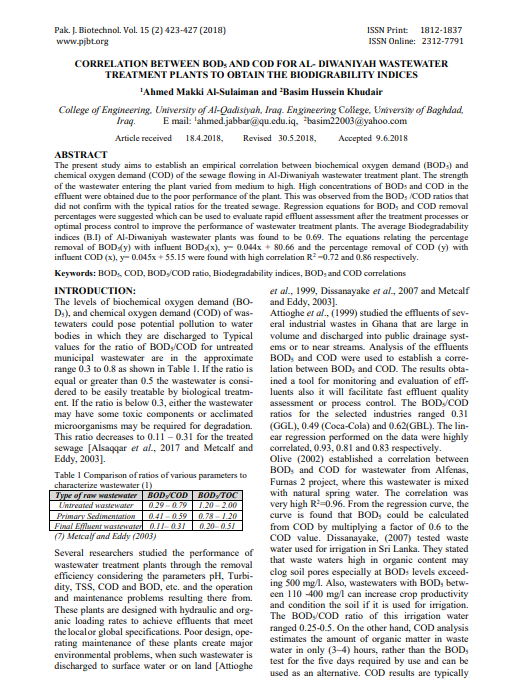

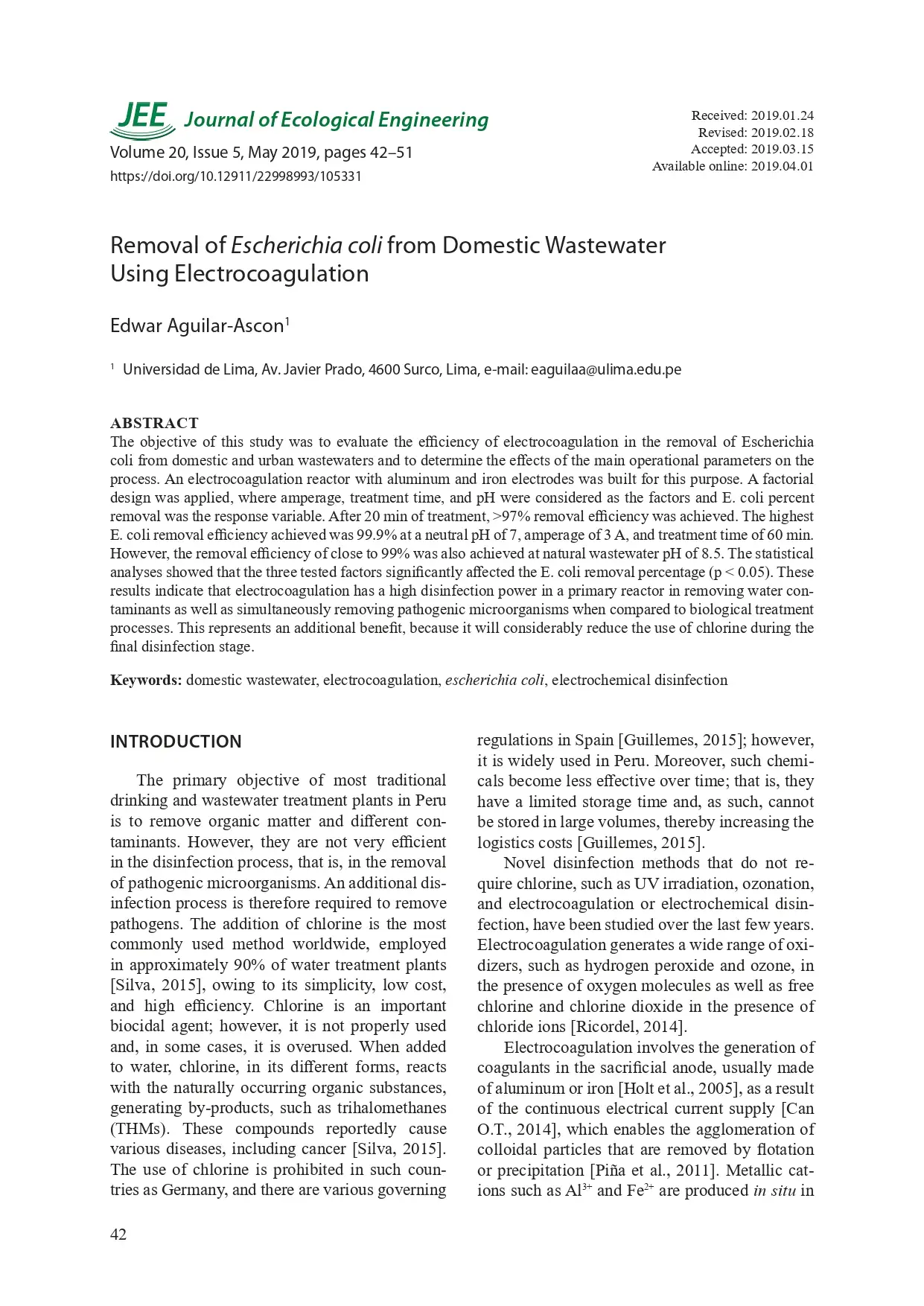
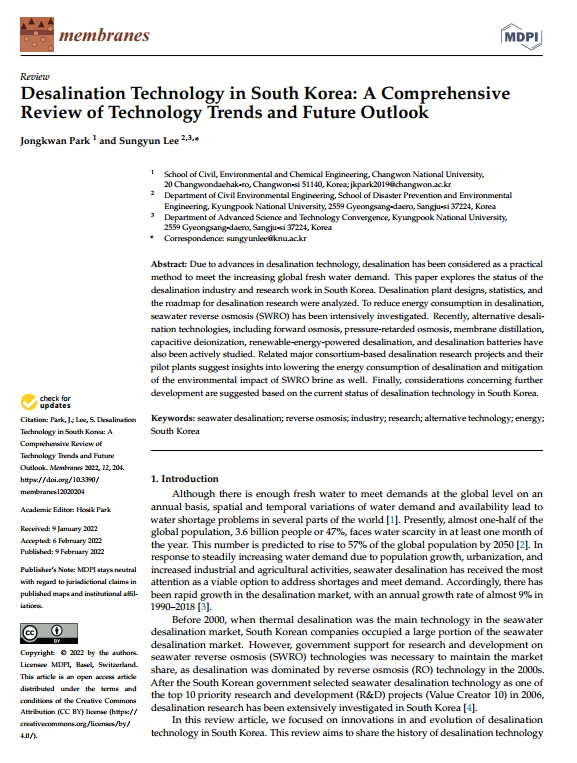

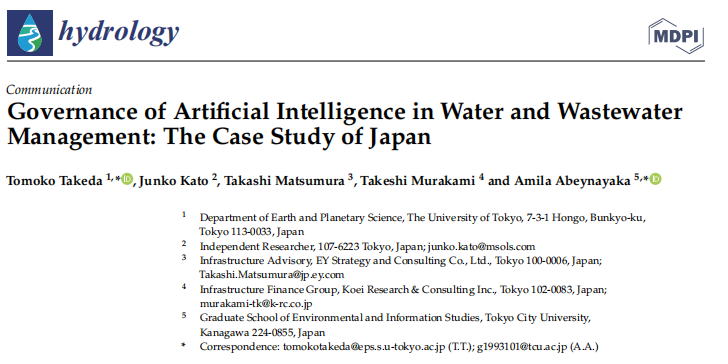
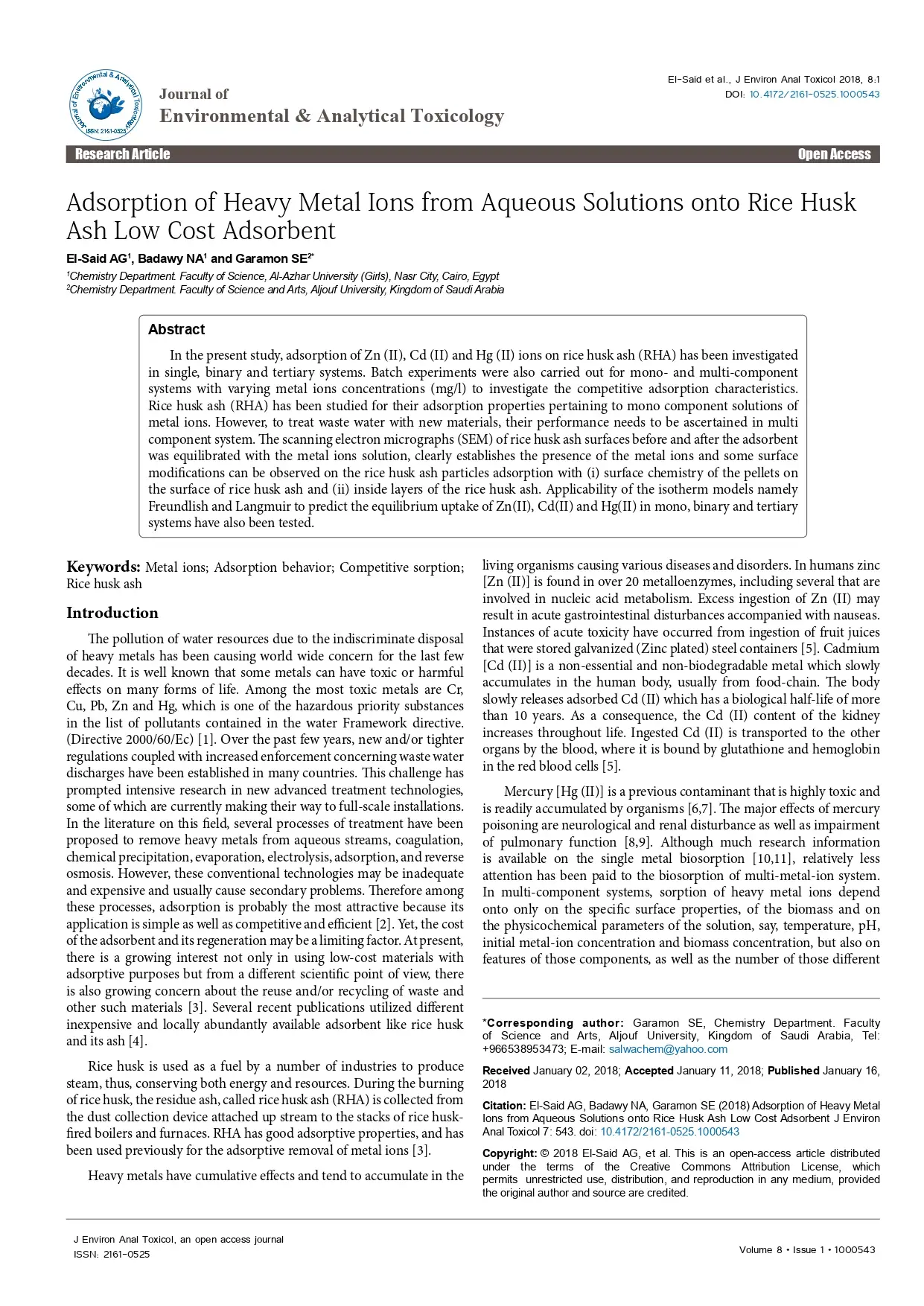
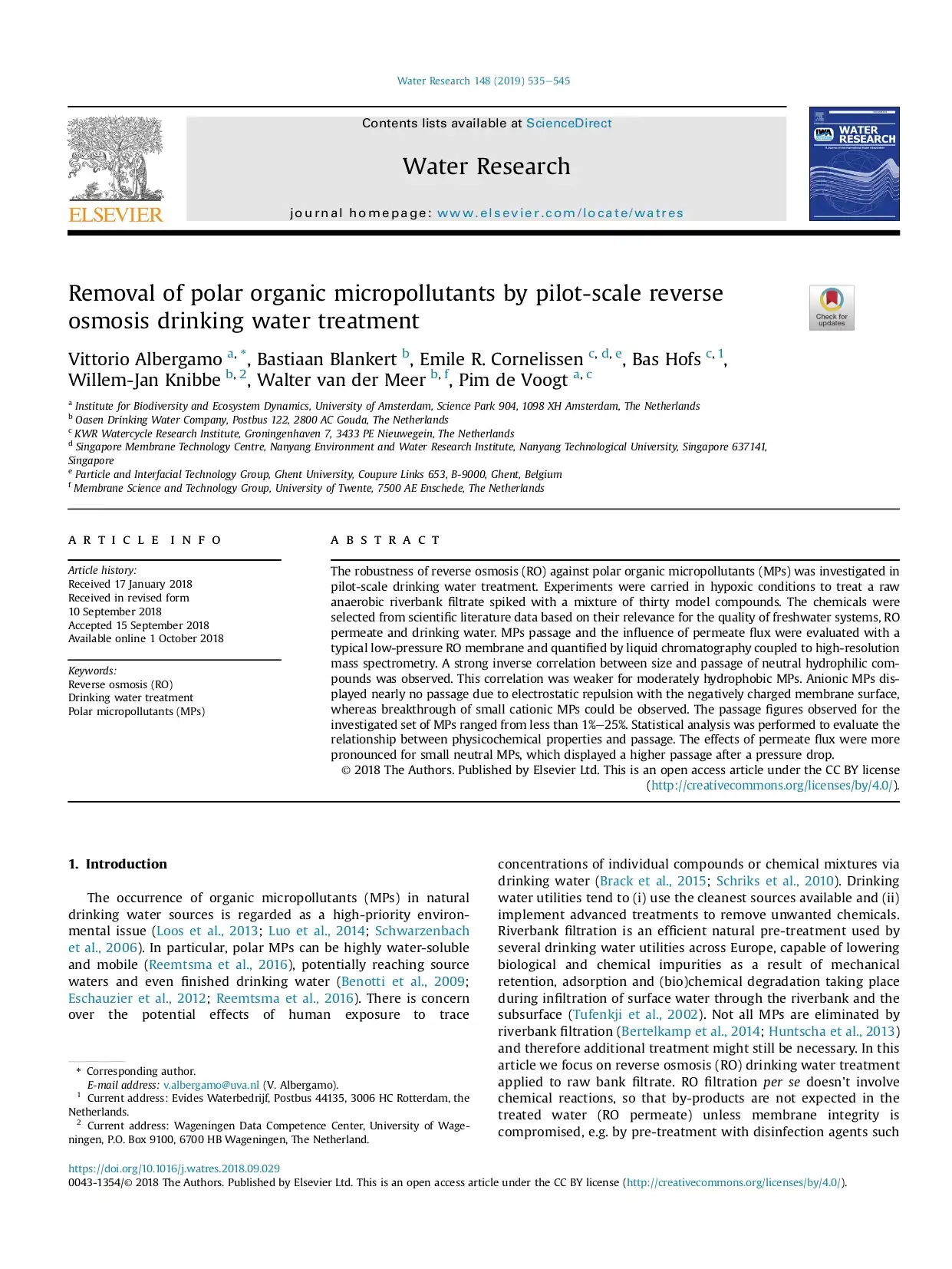
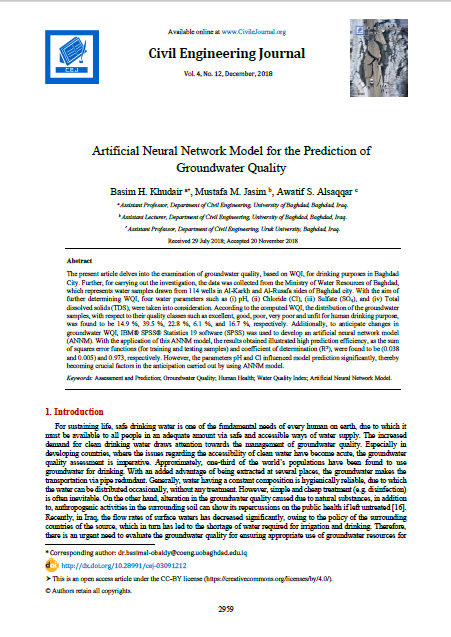
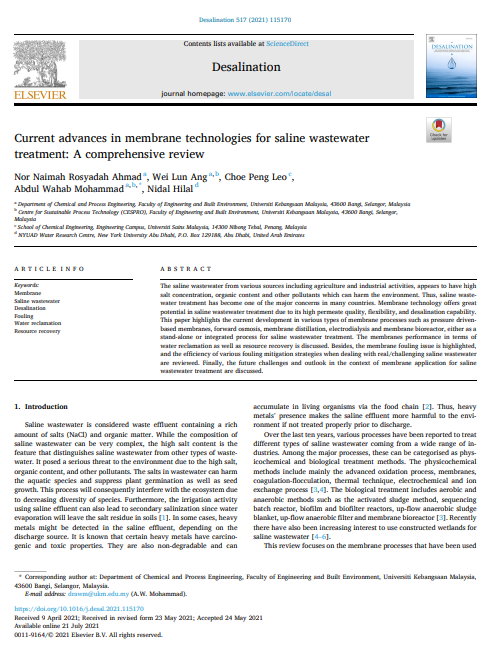
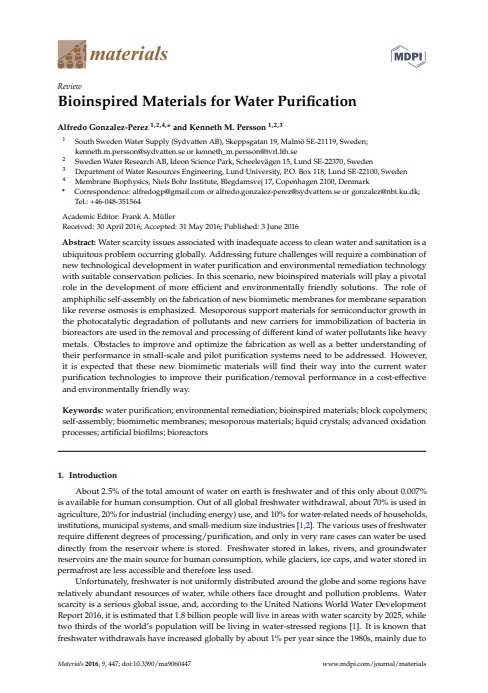
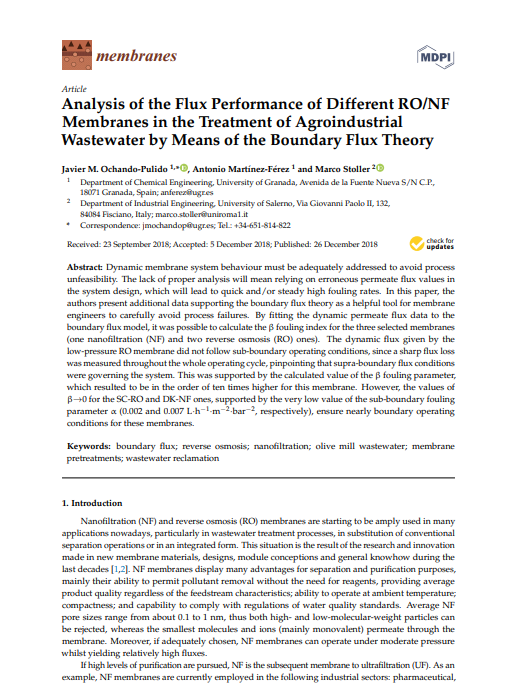
Reviews
There are no reviews yet.